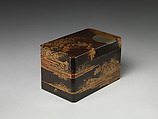Portable Stationery and Cosmetic Box (Tabi kushi-bako) with Moon and Autumn Grasses
Not on view
The composition on this box recalls bright moonlight shining on an autumn field. The custom of holding moon-viewing parties (tsukimi) in the autumn is thought to have begun in Japan among aristocrats during the Heian period (794–1185), but later became more common. While participants contemplated the full moon, sake was offered in prayer for an abundant harvest. Poetry composition was often also part of the celebration. The style of the maki-e decoration on this box follows that of the Momoyama-period (1573–1615) Kōdaiji lacquers created in Kyoto for the warlord Toyotomi Hideyoshi (1537–1598).
Due to rights restrictions, this image cannot be enlarged, viewed at full screen, or downloaded.

